Hoosier National Forest
- February 5, 2024
- 0 comment
Explore the beauty of Hoosier National Forest: vast trails, diverse wildlife, and serene landscapes await in Indiana’s natural gem. Located in the rolling hills of southern Indiana, Hoosier National Forest spans over 200,000 acres, offering an escape into nature’s untouched beauty. This verdant expanse is not just a forest; it’s a sanctuary where adventure and tranquility coexist. From the winding paths that lead eager hikers through dense woodlands to the serene waters that attract anglers and paddlers alike, Hoosier National Forest is a testament to the enduring splendor of the American wilderness.
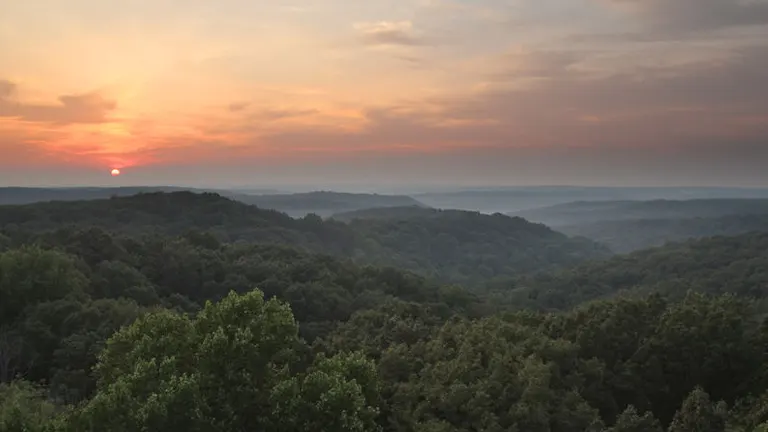
Whether you’re seeking the thrill of mountain biking, the quietude of a backcountry campsite, or the simple joy of observing wildlife in its natural habitat, this forest harbors endless possibilities for exploration and connection with the natural world.
Characterizing Features of Hoosier National Forest
- Expansive Trail System: The forest boasts over 260 miles of trails, catering to hikers, mountain bikers, and equestrians. This extensive network ranges from easy, scenic strolls to challenging, multi-day backcountry adventures. Trails like the Tecumseh Trail offer long-distance treks through the heart of Indiana’s wilderness, providing opportunities for immersive experiences in the forest’s diverse habitats.
- Wilderness Areas: Among its many attractions, Hoosier National Forest includes designated wilderness areas, such as the Charles C. Deam Wilderness. These areas are preserved in their natural state, offering a haven for wildlife and a retreat for visitors seeking solitude and a primitive outdoor experience. The management of these lands emphasizes minimal human impact and self-reliant recreation, ensuring the preservation of wilderness character for future generations.
- Historical and Cultural Sites: The forest is not only a natural treasure but also a custodian of American history. Sites like the Pioneer Mothers Memorial Forest and the Rickenbaugh House offer a window into the past, highlighting the area’s cultural heritage and the lives of early settlers. These sites provide educational value, allowing visitors to connect with the human stories intertwined with the land.
- Diverse Ecosystems: Hoosier National Forest’s ecosystems range from dense hardwood forests to wetlands and grasslands, each supporting a rich variety of plant and animal life. This biodiversity is a result of the forest’s varied topography and the intersection of different ecological regions, making it a critical area for conservation and study. The forest acts as a living laboratory for ecological research and a refuge for species that depend on these habitats for survival.
- Recreational Lakes and Rivers: Water bodies such as Patoka Lake and Monroe Reservoir enhance the forest’s recreational appeal, offering boating, fishing, swimming, and scenic waterfront camping opportunities. These lakes and rivers are not only recreational hotspots but also vital habitats for aquatic species and birds. The presence of clean, accessible water adds another layer to the forest’s recreational diversity and ecological importance.
- Scenic Overlooks and Natural Landmarks: Scenic overlooks and natural landmarks dot the landscape of Hoosier National Forest, providing breathtaking views and unique geological features. The Hemlock Cliffs offer a stunning display of sandstone cliffs and seasonal waterfalls, creating a picturesque setting for photography and nature observation. These natural attractions draw visitors for their beauty and serve as reminders of the geological forces that have shaped the land over millennia.
- Managed Wildlife Habitats: The forest includes areas specifically managed for wildlife habitat conservation, supporting species like the Indiana bat, wild turkey, and white-tailed deer. These management efforts help maintain balanced ecosystems and healthy wildlife populations, contributing to biodiversity and offering opportunities for wildlife viewing and hunting under regulated conditions.
History of Hoosier National Forest
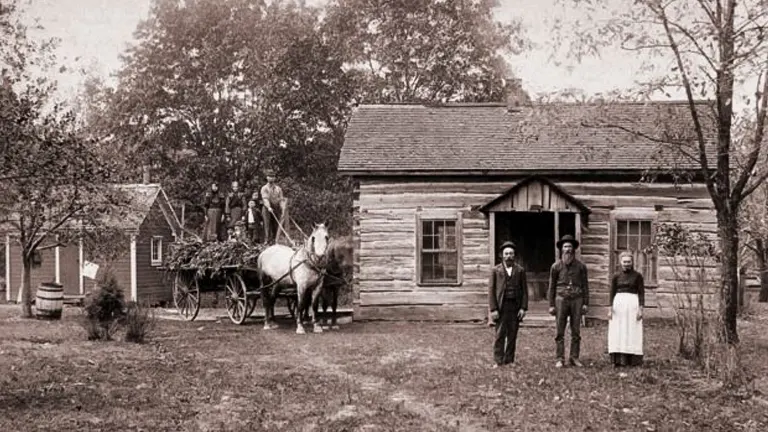
Established in 1935, Hoosier National Forest was created to address environmental degradation caused by excessive logging, poor agricultural practices, and mining. Spanning over 200,000 acres in southern Indiana, it represents a significant effort in land rehabilitation and conservation in the United States. The involvement of the Civilian Conservation Corps was crucial in its early development, contributing to reforestation, trail construction, and the establishment of recreational facilities. Today, the forest is a crucial habitat for wildlife, offers numerous recreational opportunities, and stands as a model of successful ecological restoration and sustainable land management, showcasing the benefits of conservation efforts for both nature and society.
Unique Ecosystem of Hoosier National Forest

The Hoosier National Forest hosts a unique ecosystem characterized by its diversity and the intersection of multiple ecological regions. This blend results in a rich mosaic of hardwood forests, wetlands, and grasslands, supporting a wide array of plant and animal species. Its geographical position at the edge of the Eastern forests and near the Midwest prairies contributes to this biodiversity, making it a critical habitat for both common and rare species, including the endangered Indiana bat and a variety of migratory birds. The forest’s ecosystems also play a significant role in water filtration and carbon storage, showcasing the intrinsic value of preserving natural landscapes. Through its management practices, Hoosier National Forest exemplifies the balance between conservation efforts and recreational use, ensuring the sustainability of its unique ecological resources for future generations.
Location of Hoosier National Forest

Hoosier National Forest is situated in the rolling hills of southern Indiana, USA, encompassing over 200,000 acres across several counties, including parts of Monroe, Brown, and Lawrence. It lies within close proximity to major urban areas, such as Bloomington and Louisville, Kentucky, making it an accessible destination for outdoor enthusiasts. The forest’s varied terrain and scenic beauty, combined with its accessibility, make it a cherished natural resource and recreational haven in the Midwest.
Here are some specific guidelines on how to reach Hoosier National Forest:
From Indianapolis, IN:
- Take I-65 S toward Louisville.
- Merge onto IN-46 W via Exit 68 toward Nashville/Bloomington.
- Continue on IN-46 W to enter the northern part of Hoosier National Forest near Bloomington.
From Louisville, KY:
- Take I-64 W toward St. Louis.
- Take Exit 119 for IN-37 N toward Paoli/Indianapolis.
- Follow IN-37 N into the heart of Hoosier National Forest.
From Evansville, IN:
- Take I-64 E toward Louisville.
- Exit onto IN-37 N toward Tell City/English.
- IN-37 N becomes IN-237 N; follow it to reach the western sections of Hoosier National Forest.
Public Transportation:
- Public transportation options are limited, but regional bus services may offer routes to towns near the forest boundaries. From there, taxi or ride-sharing services can be used to enter the forest.
Nearest Airports:
- For those flying in, the closest major airports are Louisville International Airport (SDF) in Kentucky and Indianapolis International Airport (IND) in Indiana. Both offer car rental services for the drive to the forest.
Using GPS and Map Apps:
- Input specific destinations within Hoosier National Forest, such as “Hardin Ridge Recreation Area” or “Charles C. Deam Wilderness,” into your GPS or smartphone mapping app for direct routes.
Local Visitor Centers:
- Visit local visitor centers in Bloomington or Bedford for maps, directions, and advice on reaching different parts of the forest.
Trailhead Parking:
- Once near the forest, look for signage directing you to trailheads and recreation areas, where parking is available for visitors planning to hike or explore the area.
The Importance of Conservation and Recreation in Hoosier National Forest
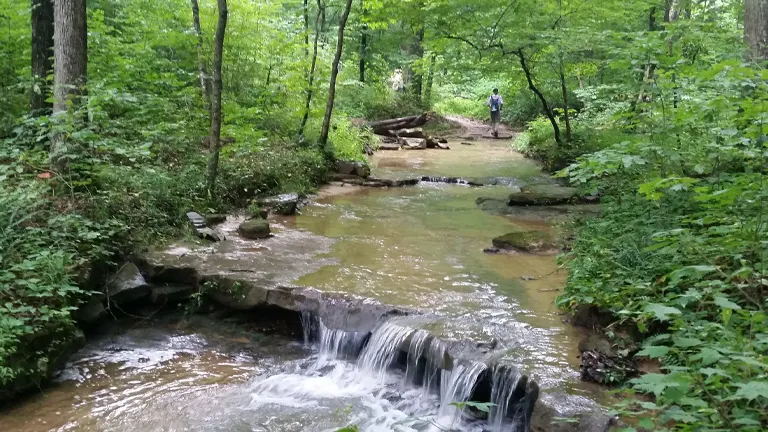
The symbiotic relationship between conservation and recreation in Hoosier National Forest is a testament to the foresight of its stewards. Conservation efforts ensure that the forest’s ecosystems, from its verdant underbrush to its towering canopies, are preserved, allowing future generations to enjoy and learn from its unspoiled beauty. Recreation, in turn, fosters a deep appreciation for these natural wonders, encouraging public support for conservation initiatives. The forest not only serves as a recreational haven but also as a living classroom, showcasing the success of ecological restoration and sustainable land management practices.
Diverse Vegetation and Plant Species in Hoosier National Forest
- American Beech (Fagus grandifolia): This majestic tree is easily identifiable by its smooth, gray bark and broad, green leaves. American Beech trees create dense canopies, providing habitat and food for numerous wildlife species. Their presence is indicative of the forest’s mature, undisturbed hardwood ecosystems.
- Eastern Hemlock (Tsuga canadensis): Found in the cooler, moist ravines and north-facing slopes of the forest, Eastern Hemlock trees add to the biodiversity and beauty of the landscape. These conifers play a critical role in regulating stream flow and temperature, supporting a unique aquatic ecosystem beneath their shade.
- Tulip Tree (Liriodendron tulipifera): Also known as the Tulip Poplar, this tree is notable for its distinctive tulip-shaped flowers and leaves. As Indiana’s state tree, it stands tall in the forest, contributing to the canopy structure and serving as an important source of nectar for pollinators.
- Wild Ginseng (Panax quinquefolius): This understory herb is prized for its medicinal value and is a species of conservation concern due to overharvesting. Wild Ginseng prefers the shaded, moist soils of the forest’s undisturbed areas, and its presence is a sign of a healthy, intact woodland ecosystem.
- Black Walnut (Juglans nigra): Recognizable by its dark, ridged bark and large, compound leaves, the Black Walnut is valued not only for its nuts but also for its high-quality wood. These trees are often found in the richer, well-drained soils of the forest, contributing to the area’s economic and ecological diversity.
- Blue-eyed Grass (Sisyrinchium angustifolium): Despite its name, Blue-eyed Grass is actually a member of the iris family, showcasing delicate blue flowers that add a splash of color to the forest floor in spring. This plant thrives in the moist, open areas of the forest, attracting various pollinators.
- Pink Lady’s Slipper (Cypripedium acaule): This rare and striking orchid, with its distinctive pink slipper-shaped flower, is a highlight for many botanists and nature enthusiasts visiting the forest. Pink Lady’s Slipper requires acidic soil conditions and is often found in pine and mixed hardwood forests, symbolizing the delicate balance of the forest’s ecosystem.


Fauna in Hoosier National Forest
- White-tailed Deer (Odocoileus virginianus): A common yet charismatic species, white-tailed deer are integral to the forest ecosystem, influencing vegetation patterns through their grazing habits. Their adaptability allows them to thrive in the diverse habitats within the forest.
- Indiana Bat (Myotis sodalis): This federally endangered species finds refuge in the forest’s caves and old growth trees. Conservation efforts in Hoosier National Forest are crucial for the survival of the Indiana bat, which relies on the forest for foraging and roosting.
- Barred Owl (Strix varia): Known for its distinctive “Who cooks for you?” call, the barred owl is a nocturnal predator that contributes to the forest’s biological diversity by controlling rodent and insect populations.
- Eastern Box Turtle (Terrapene carolina carolina): Often spotted in the forest’s underbrush, the eastern box turtle is a terrestrial species with a distinctive domed shell. It plays a role in seed dispersal, aiding in the health and spread of many plant species.
- Bobcat (Lynx rufus): As the forest’s top predator, bobcats play a critical role in maintaining the balance of its ecosystems by controlling the populations of small mammals and birds.
- Red-tailed Hawk (Buteo jamaicensis): Soaring high above the canopy, the red-tailed hawk is a common sight in Hoosier National Forest. These birds of prey are vital for maintaining healthy populations of rodents and other small animals.
- Wild Turkey (Meleagris gallopavo): Having been reintroduced to the area, wild turkeys are now thriving. They are significant for their role in seed dispersal and as an indicator of the forest’s ecological health.
- American Woodcock (Scolopax minor): This ground-dwelling bird is known for its unique “peent” call and spectacular courtship flights. Woodcocks rely on the forest’s moist soil areas to forage for earthworms, making them an important species for indicating the health of wetland habitats.
- Eastern Hellbender (Cryptobranchus alleganiensis): This large aquatic salamander lives in the clean, fast-flowing rivers of the forest. As a bioindicator, its presence reflects the health of the forest’s aquatic ecosystems.
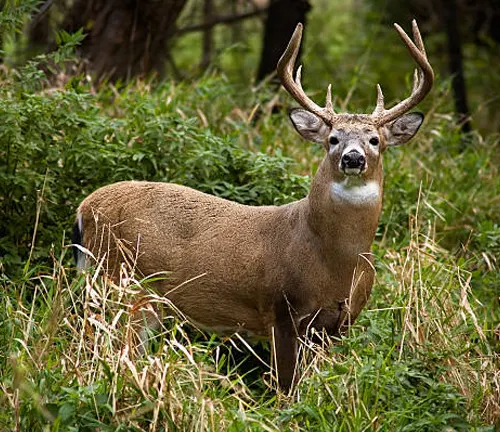
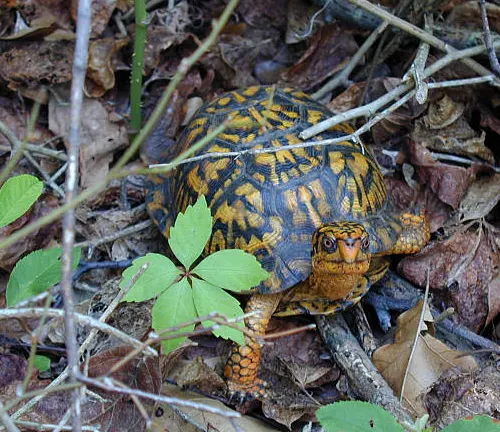
Attractions in Hoosier National Forest
Charles C. Deam Wilderness Area: The only designated wilderness area within Hoosier National Forest, Charles C. Deam Wilderness offers an immersive nature experience, free from the interruptions of modern life. Covering over 13,000 acres, it provides a sanctuary for backpacking, hiking, and horseback riding on trails that meander through dense forests, over rugged hills, and along serene lakeshores, emphasizing solitude and a primitive outdoor experience.
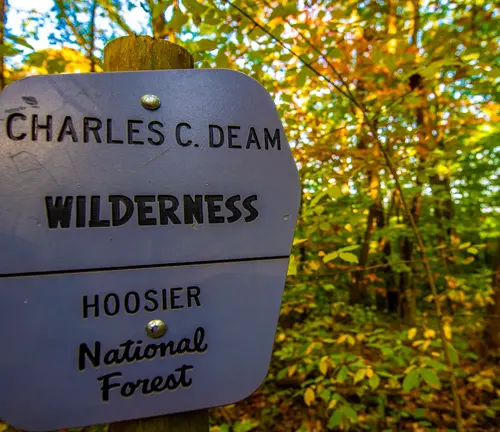
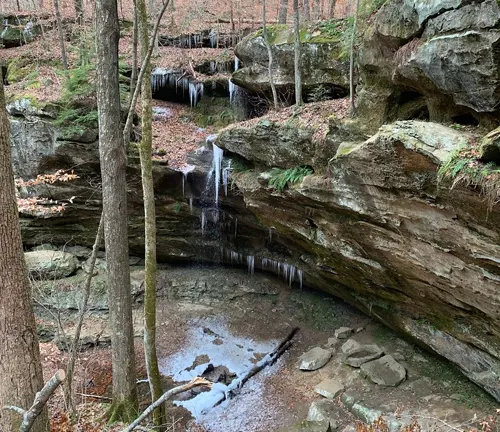
Hemlock Cliffs: This scenic area features a box canyon rich with lush vegetation, stunning rock formations, seasonal waterfalls, and cool hemlock trees. The Hemlock Cliffs Trail, a short loop, offers visitors a relatively easy hike to view these natural beauties up close, making it a perfect spot for photography, nature observation, and peaceful reflection.
Patoka Lake: As the second-largest reservoir in Indiana, Patoka Lake is a hub for water-based recreation within Hoosier National Forest. It offers boating, fishing, swimming, and wildlife viewing opportunities. The lake is surrounded by trails and picnic areas, making it ideal for a family day out or a tranquil retreat by the water.

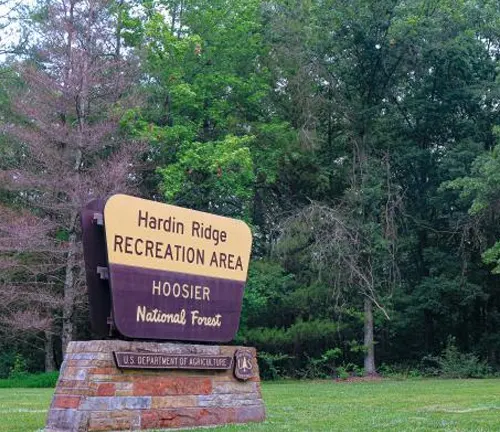
Hardin Ridge Recreation Area: Located on the shores of Monroe Lake, Hardin Ridge offers camping, picnicking, swimming, and boating facilities amidst the backdrop of the forest’s stunning natural landscape. The area features a beach, boat ramps, and trails, catering to all who seek both relaxation and adventure in the great outdoors.
Lick Creek Trail: Offering a mix of easy to moderate trails, Lick Creek Trail is ideal for hikers and mountain bikers looking for a less crowded experience. The trail winds through diverse ecosystems, including dense woodlands and open meadows, showcasing the varied flora and fauna of the region. It’s a great place for those wanting to immerse themselves in the tranquility of nature.
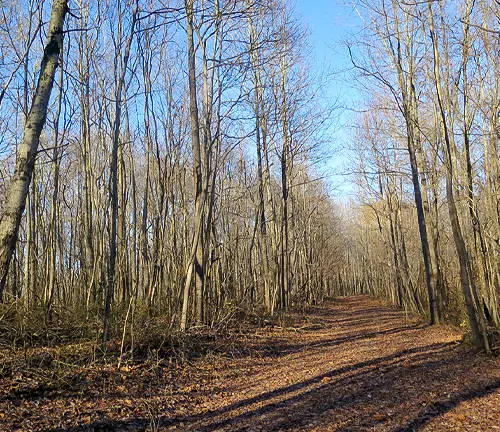
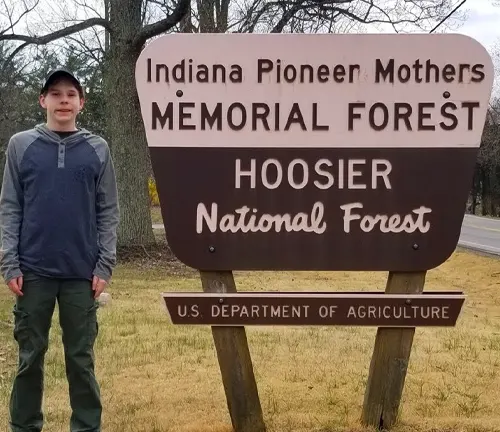
Pioneer Mothers Memorial Forest: This 88-acre tract of old-growth forest serves as a living museum, showcasing what much of Indiana’s landscape resembled prior to settlement. The trail through Pioneer Mothers Memorial Forest offers a gentle hike suitable for all ages, providing educational signage on the ecology and history of the area, making it a valuable stop for nature lovers and history buffs alike.
Buzzard Roost Recreation Area: Offering one of the best overlooks in the forest, Buzzard Roost Recreation Area presents breathtaking views of the Ohio River and the surrounding hills. The short but steep hike to the overlook is well worth the effort, providing a perfect spot for sunset views and landscape photography.
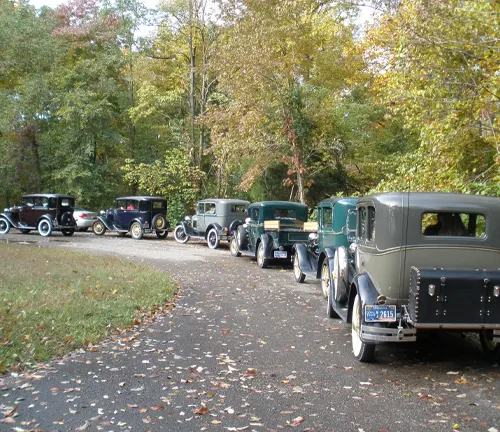
Recreational Activities in Hoosier National Forest
- Hiking: Hoosier National Forest is a hiker’s paradise, offering over 260 miles of trails that cater to all levels of experience. From the challenging, long-distance Tecumseh Trail to the scenic and accessible trails around Hemlock Cliffs, the forest provides a diverse array of landscapes to explore on foot. Hiking in the forest allows visitors to immerse themselves in its natural beauty, encounter wildlife, and discover the tranquility of the wilderness.
- Mountain Biking: The forest offers several trails designated for mountain biking, providing thrilling rides through its varied terrain. Trails such as the Nebo Ridge Trail challenge riders with its rugged landscapes, while others offer more leisurely rides through peaceful forest settings. Mountain biking in Hoosier National Forest is a great way to experience its scenic vistas and test your endurance on the trails.
- Horseback Riding: With miles of trails and old roads open to equestrians, Hoosier National Forest is a fantastic destination for horseback riding. The Hickory Ridge Trail System, for instance, offers extensive routes through remote areas of the forest, allowing riders and their horses to enjoy the serenity and natural beauty of the area. Horse camps provide convenient access to trailheads, making it easy for visitors to plan multi-day riding adventures.
- Camping: The forest caters to all camping preferences, from developed campgrounds with amenities like showers and electric hookups to primitive, backcountry sites for those seeking a more secluded experience. Hardin Ridge and Tipsaw Lake Recreation Areas are popular for their well-maintained facilities and beautiful settings, offering a peaceful retreat under the stars amidst the sounds of nature.
- Fishing: With numerous streams, rivers, and lakes, including the expansive Monroe Lake and Patoka Lake, Hoosier National Forest is a prime spot for fishing. Anglers can cast their lines for bass, catfish, panfish, and trout in these waters. Fishing in the forest not only offers a chance to reel in a big catch but also provides a peaceful way to connect with the water and wildlife of the area.
- Hunting: The forest is open to hunting for a variety of game, including deer, turkey, and squirrel, in accordance with state regulations. Hunting in Hoosier National Forest is a way for visitors to engage in the traditional outdoor activity while contributing to the management of wildlife populations. Hunters are reminded to follow all state and federal regulations to ensure a safe and responsible hunting experience.
- Bird Watching: With its diverse ecosystems, the forest is a haven for birdwatchers, offering opportunities to see a wide range of bird species in their natural habitats. From the songbirds of the hardwood forests to the waterfowl of the lakes and wetlands, bird watching in Hoosier National Forest is a rewarding activity for nature enthusiasts eager to spot and identify the avian inhabitants of the region.
- Picnicking: For those looking for a more leisurely way to enjoy the forest, numerous picnic areas are scattered throughout, offering beautiful spots to enjoy a meal outdoors with family and friends. These areas, such as those found at the Celina Lake Recreation Area, provide tables, grills, and often playgrounds, making them perfect for a relaxing day spent enjoying the forest’s natural beauty and tranquility.
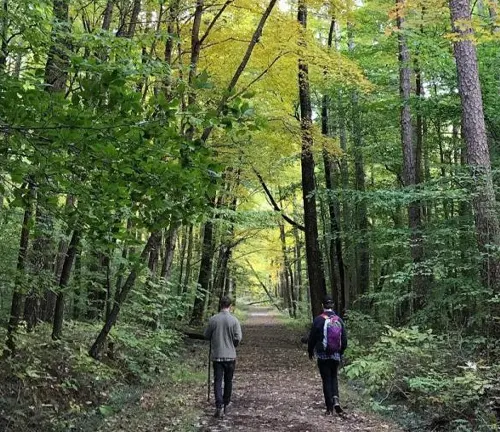
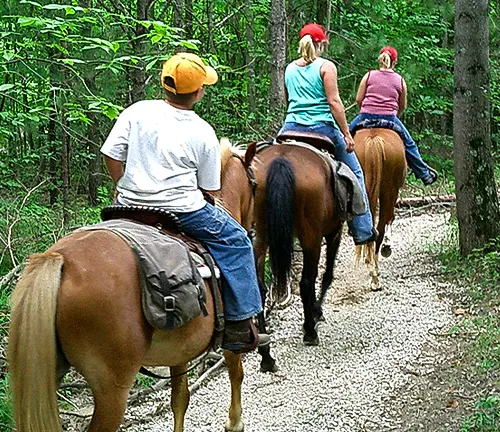
Different Facilities and Amenities in Hoosier National Forest
- Campgrounds: Hoosier National Forest offers a variety of camping options to accommodate different preferences, from primitive backcountry sites for those seeking solitude to developed campgrounds with modern conveniences. Facilities like Hardin Ridge and Tipsaw Lake Recreation Areas provide campers with amenities such as electrical hookups, potable water, and shower facilities, enhancing the camping experience with comfort while surrounded by nature.
- Picnic Areas: Scattered throughout the forest, picnic areas provide the perfect setting for a family outing or a quiet lunch in the woods. These areas are equipped with picnic tables, grills, and sometimes pavilions, offering a convenient and scenic spot to enjoy a meal. Locations like the Saddle Lake Recreation Area not only offer picnic facilities but also access to trails and fishing spots.
- Hiking Trails: The forest boasts an extensive network of trails, ranging from short, easy walks to challenging, multi-day hikes. Trails are well-marked and maintained, offering safe access to the forest’s diverse landscapes. Informational signage along some trails enhances the hiking experience by providing educational insights into the area’s ecology, geology, and history.
- Boat Launches and Fishing Piers: For anglers and boaters, the forest provides boat launches and fishing piers at lakes and reservoirs, including Monroe Lake and Patoka Lake. These facilities offer easy access to the water for fishing, boating, and other water-based recreational activities. The fishing piers are accessible, ensuring that everyone has the opportunity to enjoy fishing in the forest’s waters.
- Equestrian Trails and Horse Camps: Equestrian enthusiasts can find miles of trails specifically designated for horseback riding, as well as horse camps that provide convenient access to trailheads. These camps offer amenities such as hitching posts, water for horses, and sometimes corrals, catering to the needs of riders and their equine companions.
- Mountain Biking Trails: Certain trails within the forest are open to mountain bikers, offering a range of riding experiences from easy, scenic routes to challenging technical trails. These trails are designed to provide an enjoyable experience for cyclists of all skill levels, allowing them to explore the forest’s natural beauty on two wheels.
- Visitor Centers: Visitor centers, such as the one at Bedford, serve as gateways to the forest, offering maps, brochures, and expert advice to help visitors plan their activities. These centers also provide educational displays on the forest’s ecosystems, wildlife, and history, enriching the visitor experience with valuable insights into the area’s natural and cultural heritage.
- Restrooms and Sanitation Facilities: Developed areas within the forest, including campgrounds and picnic areas, are equipped with restrooms and sanitation facilities. These amenities, ranging from flush toilets in some areas to vault toilets in more remote locations, ensure that visitors can enjoy the forest comfortably and responsibly, minimizing their impact on the natural environment.
Tips and Advice for Visiting Hoosier National Forest
- Plan Ahead: Before visiting Hoosier National Forest, research the specific areas you plan to explore, including trail conditions, weather forecasts, and any seasonal closures or restrictions. The forest spans a large area with diverse habitats and recreational opportunities, so knowing what to expect can help you prepare adequately, ensuring a more enjoyable and safe experience.
- Leave No Trace: Practice Leave No Trace principles to minimize your impact on the environment. This includes packing out all trash, staying on designated trails to avoid damaging sensitive habitats, and camping at least 200 feet from lakes and streams. Respecting these guidelines helps preserve the forest’s natural beauty and biodiversity for future visitors.
- Check for Permits: Some activities in Hoosier National Forest, such as camping in certain areas or hunting, may require permits or reservations. Check the U.S. Forest Service website or contact forest offices for the latest information on permits to ensure compliance with all regulations and avoid any inconvenience.
- Be Prepared for Changing Weather: Weather in southern Indiana can be unpredictable, with sudden changes that could affect your visit. Pack layers of clothing to adapt to varying temperatures, and always bring rain gear, even if the forecast looks clear. Being prepared for different weather conditions will make your trip more comfortable and safer.
- Stay Safe: Familiarize yourself with safety guidelines for outdoor activities you plan to engage in, whether it’s hiking, biking, or boating. Bring a first-aid kit, plenty of water, and a map or GPS device. If you’re venturing into remote areas, let someone know your plans and expected return time.
- Protect Wildlife: Observe wildlife from a distance and do not feed animals, as this can alter their natural behaviors and harm their health. Feeding wildlife also increases the risk of negative encounters. Keeping a safe distance respects the wild nature of the forest’s inhabitants and ensures a harmonious coexistence.
- Use Fire Responsibly: If you plan to have a campfire, use designated fire rings or pits, and never leave a fire unattended. Check fire restrictions before your visit, as they may change depending on conditions. Always completely extinguish your fire before leaving to prevent wildfires.
- Explore Beyond the Popular Spots: While well-known sites like the Charles C. Deam Wilderness and Hemlock Cliffs are must-sees, Hoosier National Forest is full of hidden gems. Exploring less-traveled areas can lead to more serene experiences and a deeper connection with nature. Always respect the solitude of these areas by minimizing noise and impact.
Recommendation
For a truly unforgettable experience, spend a weekend camping at the Charles C. Deam Wilderness, where you can disconnect from the hustle and bustle of daily life and reconnect with nature. Start with a hike on the Sycamore Loop for panoramic views and end your day stargazing in the clear night sky.
Conclusion
Hoosier National Forest is not just a destination; it’s a vibrant, living ecosystem that offers a sanctuary for wildlife and a retreat for humans. Its well-preserved landscapes and rich biodiversity remind us of the intrinsic value of the natural world and the ongoing need for conservation. Whether you’re seeking adventure, tranquility, or a deeper connection with nature, Hoosier National Forest welcomes you with open arms.
FAQs
- What unique wildlife spotting opportunities does Hoosier National Forest offer?
Hoosier National Forest is a haven for wildlife enthusiasts. Unique spotting opportunities include the chance to see the Indiana bat (Myotis sodalis), an endangered species, and seasonal sightings of bald eagles near large water bodies like Monroe Lake. Early morning or late evening hikes might also reveal white-tailed deer, wild turkeys, or even the elusive bobcat. - Can I explore the forest on horseback, and are there specific trails for equestrians?
Yes, the forest is very equestrian-friendly, with over 100 miles of trails designated for horseback riding. The Hickory Ridge Trail System is particularly popular among riders, offering scenic views and varied terrain. Ensure your horse is properly conditioned, and you adhere to trail etiquette for a harmonious experience with other trail users. - Are there any restrictions on fishing or hunting within the forest?
Fishing and hunting are permitted in Hoosier National Forest in accordance with Indiana state regulations. Specific seasons and regulations apply, including the need for appropriate licenses. Always check the current state guidelines and the U.S. Forest Service’s regulations before planning your fishing or hunting trip. - What are some of the forest’s conservation success stories?
One notable conservation success is the restoration of the American chestnut tree, which was devastated by blight in the early 20th century. Through careful management and partnership with conservation organizations, the forest has seen the reintroduction of blight-resistant chestnut trees. Additionally, habitat restoration efforts for the Indiana bat have helped stabilize its population within the forest. - How can I volunteer or contribute to the preservation of Hoosier National Forest?
The forest welcomes volunteers through various programs, including trail maintenance, wildlife monitoring, and educational outreach. Interested individuals can join the Hoosier National Forest Volunteer Program or participate in special events like National Public Lands Day. Donations can also be made to the National Forest Foundation, earmarked for projects within Hoosier National Forest. - What are the most family-friendly activities in the forest?
Families can enjoy a multitude of activities in Hoosier National Forest. The Hardin Ridge Recreation Area offers swimming, picnicking, and easy hiking trails suitable for all ages. The forest’s interpretive programs, such as guided nature walks and Junior Ranger activities, are also great for kids looking to learn about the environment and wildlife. - Are there any ADA-accessible facilities or trails within the forest?
Yes, Hoosier National Forest strives to be accessible to all visitors. The Tipsaw Lake Recreation Area features ADA-accessible fishing piers, picnic areas, and restrooms. Additionally, some trails, like the accessible loop around Hemlock Cliffs, offer easy terrain for visitors with mobility challenges. - What should I know about camping in the backcountry of Hoosier National Forest?
Backcountry camping in the forest offers a unique way to connect with nature but requires preparation and respect for wilderness principles. There are no fees for backcountry camping, but it’s essential to follow Leave No Trace guidelines, camp at least 100 feet from water sources, trails, and developed areas, and be mindful of fire safety. Always plan your trip, including water sources and potential weather conditions, to ensure a safe and enjoyable experience.
As you set out to explore Hoosier National Forest, remember that this forest is a shared treasure, a place of natural beauty and tranquility that calls to be explored with respect and wonder. Whether you tread its trails, paddle its waters, or simply bask in its serene landscapes, the forest offers a profound reminder of nature’s enduring splendor.

Benjamin Brooks
Forestry AuthorGreetings! I'm Benjamin Brooks, and my journey over the past 15 years has revolved around the fascinating realms of content creation, expertise in snow clearing, and the intricate world of lumberjacking and landscaping. What began as a simple curiosity about the natural world and heavy machinery has evolved into a passionate profession where my love for crafting words intertwines seamlessly with my lumberjacking and garden skills.

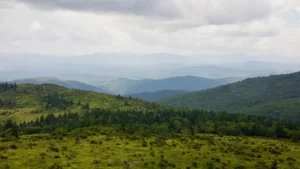
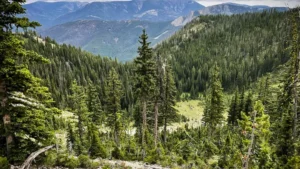
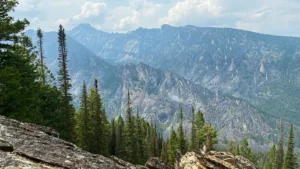
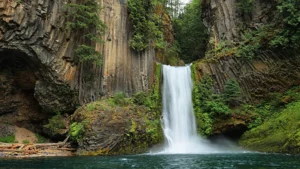
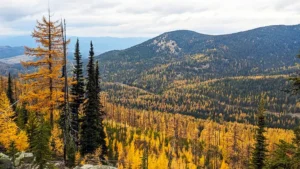
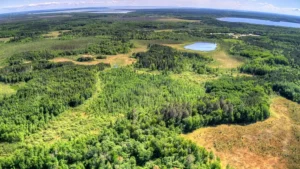
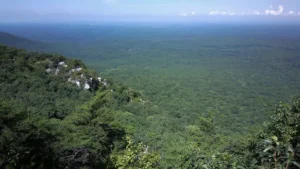
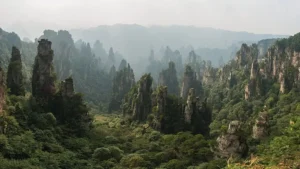
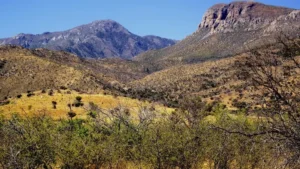
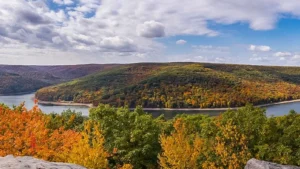
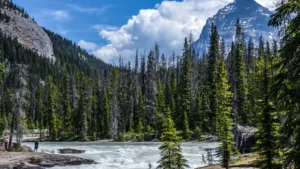
Leave your comment